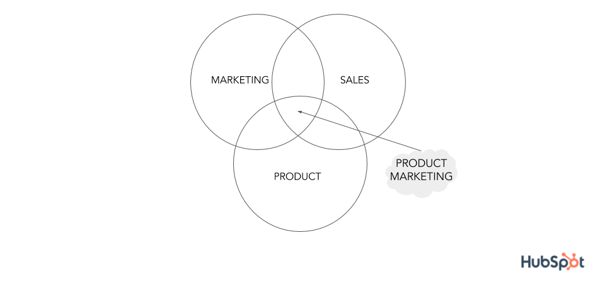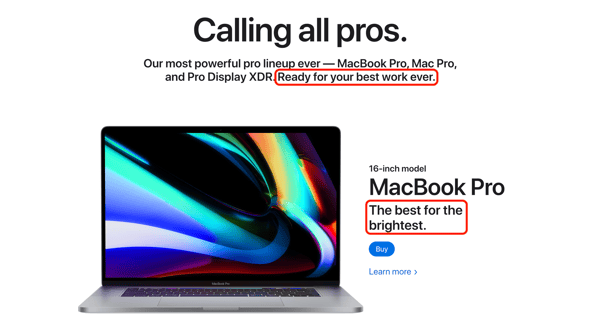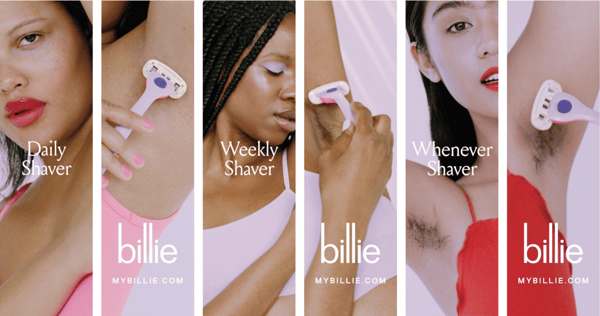During the 1950s, Volkswagen sold a bus. Although now considered a classic vehicle, the bus remains an icon for the car company decades later.
The cool part? Volkswagen announced their new VW Bus — it’s electric and features sleek, modern styling. Volkswagen’s marketing for the vehicle is eye-catching, unique, and fun, and it complements the original “hippie” vibe the company was once known for.
Source
Volkswagen also released a TV commercial for the bus that’s clever, minimalist, and on-brand. It introduces the new vehicle with the song The Sound of Silence playing in the background (hint: electric cars are silent) and ends with a short message on the screen for viewers to read: “Introducing a new era of electric driving.”
![Download Now: Free Product Marketing Kit [Free Templates]](https://no-cache.hubspot.com/cta/default/53/08b5e1f4-5d26-405b-b986-29c99bd0cb14.png)
This sentiment touches on the fact Volkswagen is contributing to society’s interest in electric, eco-friendly vehicles. It also relates to this being a new era for the bus.
So, who works on this type of marketing? Who helps create content that excites consumers about new and updated products, like the Volkswagen bus? Who encourages consumers to buy? Product marketers.
What is product marketing?
Product marketing is the process of bringing a product to market, promoting it, and selling it to a customer. Product marketing involves understanding the product’s target audience and using strategic positioning and messaging to boost revenue and demand for the product.
What makes product marketing unique? How is it different from conventional marketing? Let’s unpack the differences.
Product Marketing vs. Conventional Marketing
Product marketing is strategic whereas conventional marketing is all-encompassing.
Product marketing is considered a component of conventional marketing. In fact, if you look at the seven Ps of marketing, you’ll see product marketing is one of the most important aspects of a business’s marketing efforts.
Product marketing is focused on driving demand for and adoption of a product among existing customers. It’s focused on the steps people take to purchase your product so product marketers can build campaigns to support this work.
Product marketing is about understanding a specific product’s audience on a deep level and developing that product’s positioning and messaging to appeal to that audience. It covers the launch and execution side of a product in addition to the marketing strategy for the product — which is why the work of a product marketer lies at the center of a business’s marketing, sales, and product teams.

Conventional marketing is focused on broader topics under the umbrella of marketing such as lead generation, SEO, and anything related to acquiring and converting new leads and customers. It’s about promoting the company and brand as a whole, including the products that are sold. These marketers make sure there’s a consistent, on-brand message behind all of the company’s content.
Why is product marketing important?
Product marketing is a critical part of any business’s marketing strategy. Without it, your product won’t achieve its maximum potential among your target audience. Let’s look at what product marketing does so you get a better idea of that I mean by this.
- Understand your customers better.
- Target your buyer personas effectively.
- Learn about your competitors (products and marketing tactics).
- Ensure the marketing, product, and sales teams are all on the same page.
- Position the product appropriately in the market.
- Boost revenue and improve sales.
There are also questions you, as a product marketer, will have to ask yourself and reflect on in regards to your product. Asking yourself these questions will help you ensure your product is a success among customers.
- Is this product suitable for today’s market?
- Is this product appropriate for our customers today?
- How is this product unique from similar products of our competitor’s?
- Is there a way to further differentiate this product from those of our competitor’s?
- Are there any products we’ve sold in the past that we wouldn’t market or sell ever again now that we look back? Is so, why not?
As you can see, product marketing requires you to look at your products from a strategic perspective to ensure they’re successful among customers in your current market.
Now, let’s take a look at the specific responsibilities you have as a product marketer (or product marketing manager).
Your responsibilities as a product marketer may vary slightly based on industry, company, products, and company size and resources. If you’re working for a startup, you may be a product marketer who also helps create the content the broader marketing team produces due to limited resources and budget. As the business grows, you may move onto a team whose sole job is product marketing.
Product Marketing Responsibilities
- Identify the buyer personas and target audience for your product.
- Successfully create and carry out your product marketing strategy.
- Work with and enable sales to attract the right customers for your new product.
- Determine your product’s positioning in the market.
- Ensure the product meets the needs of your target audience.
- Keep your product relevant over time.
Let’s take a look at six common product marketing responsibilities.
1. Identify the buyer personas and target audience for your product.
You must identify the buyer personas and audience for your product so you can target customers in a way that’s convincing and makes them want to make a purchase. This will allow you to tailor your product and its features to solve for the challenges your audience is facing.
Use templates to create buyer personas for your business.
2. Successfully create, manage and carry out your product marketing strategy.
A product marketing strategy (which we’ll review shortly) allows you to create, build, and execute content and campaigns — this supports the steps that will lead your buyer personas and customers to make a purchase.
3. Work with and enable sales to attract the right customers for your new product.
As a product marketer, you have to maintain a direct relationship with sales. You’ll work with sales to identify and attract the right customers for the product at hand and provide sales enablement materials to reps to ensure they understand the product inside and out, along with all of its features.
This way, you and your teams are on the same page in terms of what’s being shared with customers, allowing you to provide a consistent, on-brand experience for anyone who comes in contact with the product.
4. Determine your product’s positioning in the market.
One of the most important parts of your job is determining the product’s positioning in the market. Think about this process in terms of storytelling — your positioning requires you to create and tell the story of your product.
As a product marketer, you’ll work with the broader marketing team and the product team to tell this story by answering critical questions like:
- Why was this product made?
- Who is this product made for?
- What challenges does this product resolve?
- What makes this product unique?
5. Ensure your product meets the needs of your target audience.
You must also make sure your product meets the needs of your customers and target audience. Through the research conducted to determine your buyer persona’s and target audience, you should have uncovered the pain points and challenges you’re working to solve with your product.
If your product doesn’t meet the needs of your customers, they’ll have no reason to make the purchase or choose your product over your competitor’s.
6. Keep your product relevant over time.
Your product needs to stay relevant over time. As needs, expectations, and challenges change and evolve, it’s your job to make sure your product marketing strategy, and the products themselves, remain relevant among customers.
This means you may have to manage slight changes in your product marketing strategy (which we’ll discuss next), or updates and modifications to the product itself (you’ll likely work with the product team, who actually creates the product, to do this).
Product Marketing Strategy
Your product marketing strategy serves to guide the positioning, pricing, and promotion of your new product. It helps you take your product from development to launch and informs what new audience(s) and markets to which to launch and market your product.
Now, let’s take a look at five steps that can help you optimize your product marketing strategy.
1. Define your product’s target audience and buyer personas.
As mentioned, one of the main roles you have as a product marketer is to define a specific target audience and create buyer personas for the specific product being sold (different products will likely have different target audiences). This the first step to marketing your product.
By understanding your customers and their needs, challenges, and pain points, you’ll be able to ensure all aspects of your product marketing strategy (as in, the rest of the steps we’ll define below) are tailored to that target customer and persona. This way, the product and the marketing content that’s created for the product will resonate with your audience.
2. Determine the positioning and messaging to set your product apart.
After performing your customer research and learning about your audience, you’ll have identified their needs, challenges, and pain points. From here, you can think about how to highlight the ways your product resolves those challenges for your customers.
However, that doesn’t necessarily mean you’ve differentiated yourself from your competitors. After all, they are your competitors because they solve the needs of your customers in a similar way to your company.
The key to setting your product apart is positioning (which we touched on earlier) and messaging. Positioning and messaging answers key questions your customers might have about your product and what makes it unique and then turns those answers into the main points behind your product’s marketing strategy.
It’s your job as the product marketer to ensure your customers and audience know the answers to these questions and don’t have to dig around for (or make assumptions about) them.
Examples of questions you’ll need to answer to develop your product’s positioning and messaging include:
- What specifically makes our product unique?
- Why is our product better than our competitors’?
- Why are our product’s features ideal for our target audience?
- What will our customers get out of our product that they cannot get from our competitors’ products?
- Why should our customers trust and invest in us and our product?
Once you’ve answered these questions, you can compile these responses into one, impactful, and shareable statement that captures your positioning and messaging as a whole. To do this, follow these steps:
- Turn the answers to the positioning and messaging questions into an elevator pitch.
- Use action words to excite your customers.
- Ensure the tone of your statement captures the tone of your brand.
- Focus on the benefit of your product as a whole (not just one specific feature).
And if you need more guidance, check out the HubSpot Marketing Hub product page. The main positioning and messaging statement reads as follows: “All-in-One Inbound Marketing Software: Everything you need to launch effective marketing campaigns that make people interested in your business and happy to be your customer.”
Tip: As product marketers, you should ensure the sales, product, and (the broader) marketing teams are also aware of your positioning and messaging around the product so they too can communicate the same information to prospects and current customers.
This allows you to ensure the entire company is consistent in the content and information they share about your product. Additionally, you can provide this information to your support team if you think it’s necessary, as they may be fielding support calls and working with your customers who’ve already invested in the product.
3. Set goals for your product.
Next, you’ll want to set goals for your product. These will vary based on your specific product, the type of company you work for, your overall marketing goals, and more — your goals will be specific to your business and situation. However, let’s review some common goals product marketers aim to achieve:
- Increase revenue
- Engage with customers
- Improve market share
- Gain customers from competitors
- Boost brand recognition
Tip: Feel free to combine several of these goals or just choose one to focus on — every company and product will have different goals. The key is making sure you view and set these targets in the SMART goal format, meaning they’re specific, measurable, attainable, realistic, and time-bound.
Use a free template to help you create and achieve your SMART goals.
4. Price your product.
As a product marketer, you’ll also have to contribute to the discussion of the price of your product. Depending on the company you work for, you might work with other teams on this part of the strategy, or it might be a job just for you and your fellow product marketers. Either way, you can consider competitive vs. value-based pricing.
Competitive vs. Value-Based Product Pricing
Competitive pricing means you’re basing your product’s price off of the similar products your competitors sell. It’s ideal for companies who have created a product similar to one that several other companies sell.
If you believe your unique features warrant a significantly higher price than those of your competitors’, you might choose to price your product above the other similar products on the market. A good way to evaluate the fairness of the pricing of all of your competitors is by studying financial reports and industry trends.
Value-based pricing allows you to maximize your profit, although it’s a bit more time-consuming to establish in comparison to competitive pricing. It’s ideal for companies selling a product with very few competitors on the market or one with exceptionally new and unique features.
Value-based pricing quantifies your item’s value in a way your customer can relate to their profitability. It allows you to base your product’s price on its value for your customer rather than whatever the market, industry trends, and your competitors say.
5. Launch your product.
Now it’s time for the most important part of your role as a product marketer — not to mention, the most exciting: the launch of the product you’ve been marketing.
There are two main parts to the launch to focus on as a product marketer: the internal launch (what goes on within your company upon product launch) and external launch (what goes on outside of your company, with customers and audience members, upon product launch).
Internal Aspects of a Product Launch
As previously stated, your job as a product marketer entails making sure the entire organization is on the same page about your product. This way, your customers only receive consistent and accurate details about the product.
The marketing, product, and sales teams at your company should be aware of the following information:
- The product’s benefits
- Any available product demo information
- Sales training opportunities on your product and details about how it’s used
- What the positioning and messaging looks like
- Who your buyer personas and ideal customers are
- What the goals for your product include
- What your product’s features are
- The pricing of your product
- How your product is being launched to customers (which we’ll discuss momentarily)
Now, you might be wondering how to provide this information to marketing, product, and sales. Which channels are ideal for sharing these details with your fellow employees?
Here are a few examples of ways to do this:
External Aspects of a Product Launch
Externally, there are many ways to market your product launch so your current base of customers, prospects, and target audience learn about whatever it is you’re selling.
First, determine where you’re going to focus your product marketing efforts. Here are some examples of channels and places to do this (you might choose several of these or just one to focus on depending on your needs, goals, and resources).
- Social media
- In-store
- Product launch event
- Blog
- Website landing page
- Exclusive product preview (prior to the official launch)
- Promotional event/ campaign (in-person and/ or online)
On whatever channel you choose to focus your product launch marketing efforts, you should include relevant product information (focused on your positioning and messaging) so prospects and customers can learn all about your product and why they need it. This includes your product’s features, what makes it unique, pricing, demos for customers, training for customers, and any other materials you’ve created and want to share.
Congrats! You’ve just worked through the steps to marketing a product. Remember, this process is one that should be thought about and updated as your products change and evolve so they remain relevant among your customers. (This shouldn’t be an issue as long as you have a member of your team focused on product marketing, considering it’s one of their main responsibilities.)
Product Marketing Examples
- Apple
- Billie
- Coca-Cola
- MailChimp
Let’s review four real-life examples of stellar product marketing.
1. Apple
Apple is a household name for leading technology products and software. Not only are its products gorgeously well-designed; they’re also super useful. But Apple’s product marketing doesn’t focus on the many product features — they market the user benefits.
 Source
Source
Apple doesn’t simply list the impressive features of their products; it uses those features to tell consumers who they could be and how they could work if they purchased those products. They tell a narrative using their products and encourage people to buy in the process.
2. Billie
Billie is a women’s razor brand. In a highly competitive market, Billie has helped its products stand out. How? It established a sharp competitive edge (no pun intended) by doing what no razor brand had done before — show body hair in its advertising.
 Source
Source
Not only did this advertising approach get Billie’s audience talking about the brand, but they also appreciated the brand’s accurate portrayal of women’s bodies and body hair. These differentiators were more than enough to set Billie apart from other razor brands and products.
3. Coca-Cola
Did you know that over 95% of people around the world recognize Coca-Cola and its red and white branding? This comes as no surprise when you notice that most people order a “Coke” when purchasing a soft drink or cola. In fact, the brand recognition is so strong that Coca-Cola’s competitor Pepsi used the narrative in its Super Bowl advertising.
Through highly targeted positioning, repetitive advertising, and consistent branding, Coca-Cola has become a truly global household name and product.
4. MailChimp
There are dozens of email marketing tools on the market, but MailChimp hasn’t been fazed by competition. In fact, its risen above their competition by positioning itself as more than an email marketing tool: it’s an all-in-one marketing platform that helps businesses grow.
 Source
Source
Like Apple, MailChimp primarily highlights its benefits for the end user, not just its product features. A recent rebranding and site redesign further drives this narrative home.
Start Marketing Your Products
Product marketing is the process through which a company brings a product to market. Being a product marketer (or product marketing manager) means you’re at the center of your company’s marketing, sales, and product teams.
You’re an integral part to the success of your product, as you create and manage your product’s specific marketing strategy, but you also serve as a liaison between all three of these departments, ensuring everyone is on the same page with your product, it’s features, capabilities, and more. So, start developing your latest product’s marketing strategy to ensure it’s a success among your target audience and customers.
This post was originally published in February 2020 and has been updated for comprehensiveness.

